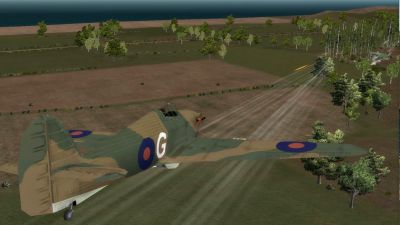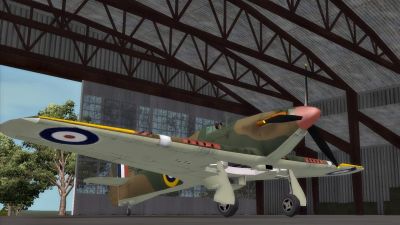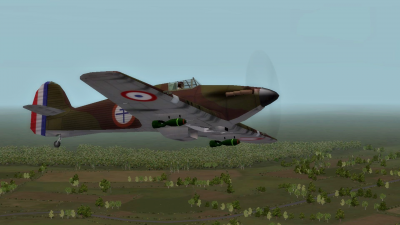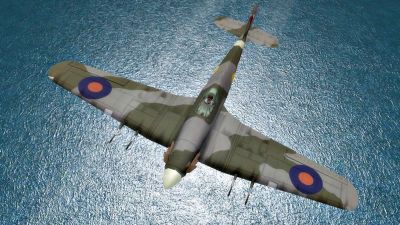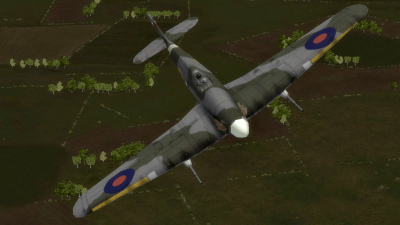Hurricane
Hawker Hurricane Mk I
History
The Hurricane was the only modern British fighter available in quantity at the beginning of the war. As Britain's first low-wing monoplane fighters design it was a huge leap forward from the biplane era such as embodied by the Gloster Gladiator and the Hawker Fury. Sturdy, reliable and highly maneuverable the Hurricane bore the brunt of fighting during the first months of shooting war in the west, though always overshadowed by the more illustrious Supermarine Spitfire. The Hurricane was however the real victor of the Battle of Britain, equipping three-fifths of the RAF and destroying twice as many aircraft as the Spitfires in the battle.
While the Hurricane I and II were considerably slower than the prevailing German fighter, the Bf-109, and struggled to keep up with both the Bf-110 and the the Ju-88, it managed to hold its own thanks to the benefit of radar assisted ground controlled interception, which gave the Hurricane formations positional advantage necessary to deliver a telling blow.
Inreasingly outclassed and with no hope of improving the airframe to compete on even terms with the Bf-109, the Hurricane was eventually relegated to ground attack missions in which it served with particular distinction over France and North Africa. Later versions of the Hurricane were operational in the Middle and Far East theatres until the end of the war, and, perhaps little known, in Europe until the end of 1944.
Game Play
The Hurricane Mk I is the basic RAF fighter plane in the early days of a Battleground Europe campaign. It is not particularly fast and does not climb as well as the more advanced Spitfire Mk I, but it does have some advantages in combat, chiefly in turn radius and diving ability. It is a stable guns platform without serious vices, and less experienced pilots find it easier to score hits with the Hurricane than with the Spitfire because the guns are all grouped evenly together, producing a tight and concentrated shot pattern at convergence range.
The Hurricane pilot, fighting against aircraft that climb better, fly faster and can sustain a dive better, must use his single remaining advantage – turning ability - to the hilt. However, this ace in the sleeve should ideally only be used when all other options have been used up: altitude, surprise, numerical superiority and teamwork. These are powerful force multipliers that the Hurricane pilot must learn to employ.
Because the enemy aircraft are always faster than the Hurricane in a level race, the aggressive Hurricane pilot must entice the enemy to turn and remain within easy grasp, where the Hurricane can utilize lead pursuit to bring his guns to bear. If the enemy does not comply but runs away, the Hurricane must break off pursuit and pretend not to care while preparing to recieve the bandit again, should he turn back for more. And if the bandit climbs away the Hurricane must extend away in the horizontal so as not to be trapped directly below the enemy where he is no more than a target for a diving attack.
On the defensive, the Hurricane pilot must likewise 'fight in circles' and either scare away his opponent or destroy him outright before he can disengage. Adding to his woes, the Hurricane pilot has no more than twelve seconds of uninterrupted fire, and his dogfighting options somewhat curtailed by a less than stellar roll rate. These two problems can be offset by a miser's fire discipline and deft use of snap rolls to increase his roll rate.
As always, going out alone is a certain recipe for disaster. The wise pilot flies in pairs, groups and gaggles, and preferably with a wingman on voice comms.
Hawker Hurricane Mk IIb
History
The Hurricane I was outclassed and all but obsolescent already when first introduced to active service, yet proved to be a sturdy and functional guns platform against enemy bombers and a fully capable ground attack aircraft. Early in the war the RAF realized that the eight rifle caliber machine guns of the Spitfire and Hurricane offered insufficient stopping power, steps were taken to increase the weight of fire by a change of fighter armament policy expressed as the widespread use of 20 mm aircraft cannon instead of the traditional machine gun.
The first measure was the construction of an ”Universal Wing” that would accomodate a variety of armaments and bombs, the second to add another four .303 machineguns to create what was called a ”twelve-gun shotgun”, as a stop-gap increase in firepower until the anticipated 20 mm Hispano cannon was made available in quantity. The most significant improvement was however the Merlin XX engine which increased output from 1,030 to 1,390 hp, giving the Hurricane IIB a much needed increase in speed and acceleration. The same Universal Wing would later carry four 20 mm Hispano cannon and up to 1,000 lb worth of bombs in the Hurricane IIC, and two Vickers Type S 40 mm cannon in the Hurricane IID variant.
Contributing to the Hurricane's fighting ability was its somewhat legendary durability, a result of the old fashioned tubular steel truss fuselage construction covered with a streamlining wooden stringer and fabric fuselage cover, which by this stage of the war made it rather unique but easy to produce construction.
Game Play
The Hurricane IIB's increase in firepower comes at a price of more weight and slightly heavier roll inertia, though with a considerably more powerful engine the difference between it and the Mk I is slight. Roll rate is still sluggish, slightly faster than a Mk I the Mk IIB is still far slower than the Luftwaffe's main fighter, and it cannot climb its way out of a tight spot for love or money.
The Hurricane Mk IIB acts much like the Mk I, so the combat advice above applies in full: fight in circles when your other advantages have eroded; fight as a team with time-honoured 'drag-and-bag' tactics; and, whenever possible, let the Hurricanes deal with the bombcarriers and engage in close air support while the better performing fighters deal with matters of air superiority. With its twelve guns and additional ammo, the Hurricane Mk IIB has the wherewithal to be a decent CAS aircraft, although it can only hope to hurt soft targets: trucks, guns and infantry.
Hawker Hurricane Mk IIb Fighter Bomber
History
By spring 1941 as Germany looked to the East after the abortive Battle of Britain, the RAF began to aggressively “lean into" Occupied Europe - with fighter sweeps, bombing raids and general mayhem. Seeking speed, surprise and pinpoint accuracy, the still active but ageing Hurricane Mk II was selected to become the RAF's first fighter-bomber platform.
Fitted with a two-stage supercharged Merlin XX engine and equipped with under wing bomb racks rated to carry two 250 lb. (112 kg) General Purpose bombs, the " Hurribomber became the staple fighter-bomber in all theatres of war and soldiered on with various engine, armour and armament upgrades until the end of hostilities.
Game Play
The Hurricane Mk IIB “Hurribomber” represents the Frist British fighter bomber to enter a Battleground Europe campaign. it is available from tier 1. It also available to the French air force. Like its predecessors it is not very fast and it does not climb very well in comparison to the opposition, which, at the time the Hurribomber debuts, is generally the much better performing Bf 109-F.
Because the Hurricane platform is always well behind the enemy on the speed and power curve, the Hurricane pilot must take this into account and fly so as to maximise his chances – for one on one, any reasonably well-handled Bf 109 has the speed and manoeuvrability to dominate the Hurricane in all aspects but one: turn radius. Knowing this the Hurricane pilot makes sure to arrive with a good head of steam and plenty of altitude to spend before he must use his remaining ace and turn for dear life, fighting in circles as described previously.
The Hurribomber likes all kinds of approaches to the combat area. Go in fast and hard on the deck for rapid attacks at low altitude; fly in teams of four to eight at medium altitude when friendly fighters own the sky; or come in from 12,000 or still higher with the engine on idle to 'bomb and run' when enemy fighters and AA guns are strongly present. For more guidance in this matter, please refer to the Close Air Support section.
Hawker Hurricane Mk IIc
History
The same Universal Wing that was first employed with the Hurricane Mk IIB was also the main feature of the Mk IIC. Both the Mk IIB and Mk IIC were dubbed ”Hurribomber” as a reflection of its newly acquired fighter-bomber role – both variants were rated to carry two 250 lb bombs, later increased to two 500 lb bombs on underwing hardpoints. The distinguishing difference between the IIB and IIC was the latter's main armament, now comprising four 20 mm Hispano cannon. Service use of the Mk IIC began in April 1941, barely three months after the IIB's combat debut.
Some Hawker Hurricane IIBs and IICs carried six, later eight, 3 inch rocket projectiles underwing, after tests starting in February 1942, further improving its capacity for ground attack.
Game Play
The Hurricane Mk IIC “Hurribomber” represents the second British fighter bomber to enter a Battleground Europe campaign, arriving in game from tier 2. Like its predecessors it is not very fast and it does not climb very well in comparison to the opposition, which, at the time the Hurribomber debuts, is generally the much better performing Bf 109-F.
Because the Hurricane platform is always well behind the enemy on the speed and power curve, the Hurricane pilot must take this into account and fly so as to maximise his chances – for one on one, any reasonably well-handled Bf 109 has the speed and manoeuvrability to dominate the Hurricane in all aspects but one: turn radius. Knowing this the Hurricane pilot makes sure to arrive with a good head of steam and plenty of altitude to spend before he must use his remaining ace and turn for dear life, fighting in circles as described previously.
While the Hurribomber has the firepower to rip enemy aircraft to shreds at a brief touch of the trigger, and many pilots take delight in using it as a pure fighter, the Hurricane Mk IIC's earns its dues as a competent ground attack platform.
Use the Hurricane IIC in strength to bring an overwhelming amount of bombs and firepower to bear where the need is the greatest. While slow for a fighter it is nevertheless faster than a bomber, and can pick and choose between targets far easier than they – and defend itself against enemy fighters should the need arise.
The Hurribomber likes all kinds of approaches to the combat area. Go in fast and hard on the deck for rapid attacks at low altitude; fly in teams of four to eight at medium altitude when friendly fighters own the sky; or come in from 12,000 or still higher with the engine on idle to 'bomb and run' when enemy fighters and AA guns are strongly present. For more guidance in this matter, please refer to the Close Air Support section.
Hawker Hurricane Mk IID
History
The " "Tank Buster"" was the second ground attack variant of the venerable Hurricane airframe, packing to hard-hitting Vickers-S 40 mm Armor piercing cannons and extra armor plate for the engine and pilot. Using the same Merlin XX engine as t's MkllC cousin, the weight and drag of the big external guns in addition to the extra armour made the MkllD a little bit slower in top speed and climb than its MkllC predecessor. The ongoing experimentation with increasingly heavy loadouts and different wing and gun packages gave the Hurricane the punch it needed to to be successful in several useful roles including that against both armour and shipping. This helped keep the rugged but dated airframe viable as a ground attack and close support fighter bomber throughout the latter half of the war. Apart from the first few production machines, all Hurri MkllD's had additional armour to protect pilot, radiator and engine from small-arms fire. Even with its extra armour and big guns, the plane was still susceptible to heavy groundfire and roving fighters, but even so, this sturdy warplane became the scourge of Rommel's armoured units in North Africa.
Game Play
| Air Units in Battleground Europe | |
|---|---|
| Fighters and fighter bombers | |
| Bf 109E-1 | Bf 109E-4| Bf 109E-4B |Bf 109F-2 | Bf 109F-4 | Bf 109G-2/R1| Bf 109G-6/U4 | Bf 110C-4 | Bf 110C-4/B | Blenheim IF | Dewoitine D.520 | Fw 190A-3B | Fw 190A-4 | Hawk 75 | Hawk 81 | Hawk 87 | P-40F Kittyhawk Fighter Bomber | | Hurricane Mk I | Hurricane Mk IIb | Hurricane Mk IIc | Hurricane Mk IID | Junkers 87G2 'Stuka' | P-38 'Lightning' | Bell Model 14a / P-400 Airacobra | Model 26 / P-39N Airacobra | Spitfire Mk Ia | Spitfire Mk IIb | Spitfire Mk Vb | Spitfire Mk IXc | |
| Bombers | |
| Blenheim IV | Douglas DB-7 | Havoc Mk.I | A20C Havoc | Heinkel 111 | Junkers Ju 88A4 | Junkers 87 'Stuka' | | |
| Transport | |
| C47 'Skytrain' | Junkers 52 | |
